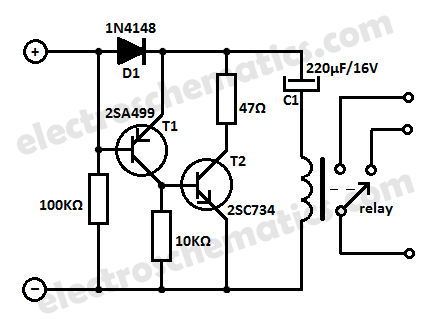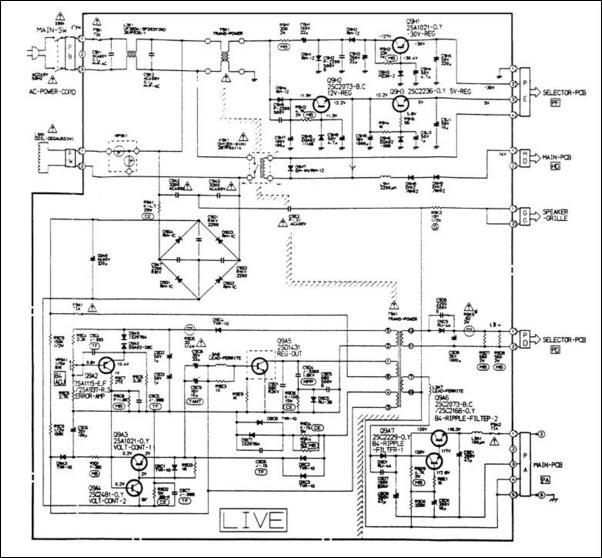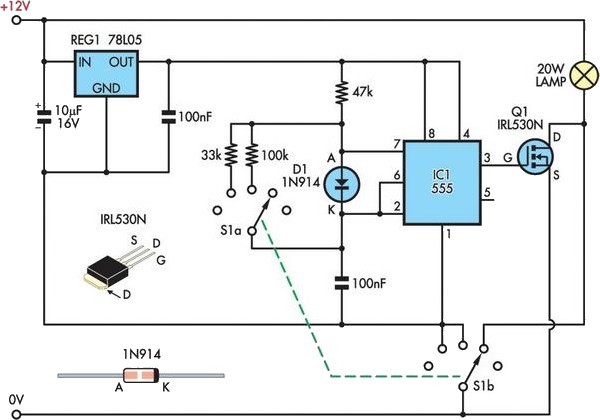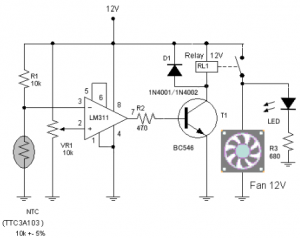
12V Fan Directly on 220V AC
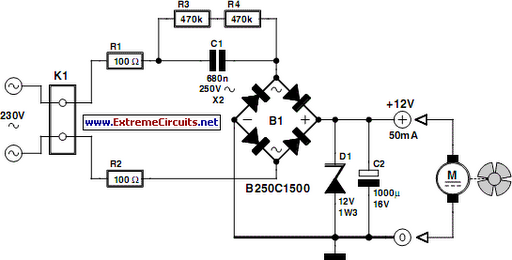
This circuit concept is not new, but it is useful when deciding between a small, short-circuit-proof transformer or a capacitive voltage divider for powering a fan directly from 230 V mains voltage. In situations where forced cooling is an afterthought and options are limited, the capacitive divider may be the only choice. At low currents, a capacitive divider occupies less space than a small transformer. Resistors R1 and R2 are included to limit the inrush current into the power supply capacitor C2 during startup. Since the maximum rated operating voltage of available resistors is often unknown, two resistors are used for current limiting. The same rationale applies to discharge resistors R3 and R4 for capacitor C1. If the circuit connects to a mains plug, it is essential to ensure that no dangerous voltage remains on the plug, which is why R3 and R4 are necessary. Capacitor C1 determines the maximum current supplied; exceeding this maximum causes the power supply to behave as a current source. If the current is lower, zener diode D1 limits the maximum voltage and dissipates the excess power. It is advisable to select the value of C1 based on the maximum expected current, starting with the mains voltage for calculations. The output voltage of 12 V, along with the forward voltage drop across diode B1 and the voltage drop across R1 and R2, can be neglected for simplicity. The calculated value should then be rounded to the nearest E-12 value. The impedance of the capacitor at 50 Hz is calculated as 1 / (2π50C). For example, to supply 50 mA, the required impedance is 4600 ohms (230 V/50 mA), leading to a capacitor value of 692 nF, which rounds to 680 nF. To accommodate variations in mains voltage and account for neglected voltage drops, it may be prudent to choose the next higher E-12 value. Alternatively, the required capacitance can be achieved using two smaller capacitors, depending on the available space. It is recommended to use a capacitor designed for mains voltage applications, such as an X2 type.
In this circuit, the design employs a capacitive voltage divider as the primary method for power supply, which is particularly advantageous in compact applications. The arrangement begins with the connection to the mains voltage, where the capacitive divider is formed by capacitor C1. This capacitor must be selected carefully to ensure it can handle the peak voltage levels without failure. The resistors R1 and R2 serve a dual purpose: they limit the initial surge current when the circuit is powered on and help protect the circuit from potential overcurrent situations.
The use of discharge resistors R3 and R4 is crucial for ensuring safety by discharging capacitor C1 when the circuit is turned off. This prevents the risk of electric shock from residual voltage at the plug. The zener diode D1 acts as a voltage clamp, ensuring that the output voltage remains within safe limits, even under varying load conditions. This diode's specification should be chosen based on the expected maximum output voltage and power dissipation.
When calculating the value of capacitor C1, it is important to consider the capacitive reactance at the operating frequency (50 Hz). The formula for calculating the required capacitance based on the desired output current is essential to ensure the circuit operates within its intended parameters. The final choice of capacitor should also consider the physical dimensions and mounting options available in the application, which may necessitate the use of multiple smaller capacitors rather than a single larger one.
Overall, this circuit design illustrates a practical approach to providing power to small fans in situations where space is limited and safety requirements must be strictly adhered to. The choice of components and their arrangement within the circuit are critical for ensuring reliable operation and compliance with electrical safety standards.This circuit idea is certainly not new, but when it comes to making a trade-of between using a small, short-circuit proof transformer or a capacitive voltage divider (directly from 230 V mains voltage) as the power supply for a fan, it can come in very handy. If forced cooling is an afterthought and the available options are limited then perhaps t here is no other choice. At low currents a capacitive divider requires less space than a small, short-circuit proof transformer. R1 and R2 are added to limit the inrush current into power supply capacitor C2 when switching on. Because the maximum rated operating voltage of resistors on hand is often not known, we choose to have two resistors for the current limit.
The same is true for the discharge resistors R3 and R4 for C1. If the circuit is connected to a mains plug then it is not allowed that a dangerous voltage remains on the plug, hence R3 and R4. Capacitor C1 determines the maximum current that can be supplied. Above that maximum the power supply acts as a current source. If the current is less then zener diode D1 limits the maximum voltage and dissipates the remainder of the power.
It is best to choose the value of C1 based in the maximum expected current. As a rule of thumb, start with the mains voltage - when calculating C1. The 12 V output voltage, the diode forward voltage drops in B1 and the voltage drop across R1 and R2 can be neglected for simplicity. The calculated value is then rounded to the nearest E-12 value. The impedance of the capacitor at 50 Hz is 1 / (2p50C). If, for example, we want to be able to supply 50 mA, then the required impedance is 4600 (230 V/50 mA).
The value for the capacitor is then 692 nF. This then becomes 680 nF when rounded. To compensate for mains voltage variations and the neglected voltage drops you could potentially choose the next higher E-12 value. You could also create the required capacitance with two smaller capacitors. This could also be necessary depending on the shape of the available space. It is best to choose for C1 a type of capacitor that has been designed for mains voltage applications (an X2 type, for example).
🔗 External reference
In this circuit, the design employs a capacitive voltage divider as the primary method for power supply, which is particularly advantageous in compact applications. The arrangement begins with the connection to the mains voltage, where the capacitive divider is formed by capacitor C1. This capacitor must be selected carefully to ensure it can handle the peak voltage levels without failure. The resistors R1 and R2 serve a dual purpose: they limit the initial surge current when the circuit is powered on and help protect the circuit from potential overcurrent situations.
The use of discharge resistors R3 and R4 is crucial for ensuring safety by discharging capacitor C1 when the circuit is turned off. This prevents the risk of electric shock from residual voltage at the plug. The zener diode D1 acts as a voltage clamp, ensuring that the output voltage remains within safe limits, even under varying load conditions. This diode's specification should be chosen based on the expected maximum output voltage and power dissipation.
When calculating the value of capacitor C1, it is important to consider the capacitive reactance at the operating frequency (50 Hz). The formula for calculating the required capacitance based on the desired output current is essential to ensure the circuit operates within its intended parameters. The final choice of capacitor should also consider the physical dimensions and mounting options available in the application, which may necessitate the use of multiple smaller capacitors rather than a single larger one.
Overall, this circuit design illustrates a practical approach to providing power to small fans in situations where space is limited and safety requirements must be strictly adhered to. The choice of components and their arrangement within the circuit are critical for ensuring reliable operation and compliance with electrical safety standards.This circuit idea is certainly not new, but when it comes to making a trade-of between using a small, short-circuit proof transformer or a capacitive voltage divider (directly from 230 V mains voltage) as the power supply for a fan, it can come in very handy. If forced cooling is an afterthought and the available options are limited then perhaps t here is no other choice. At low currents a capacitive divider requires less space than a small, short-circuit proof transformer. R1 and R2 are added to limit the inrush current into power supply capacitor C2 when switching on. Because the maximum rated operating voltage of resistors on hand is often not known, we choose to have two resistors for the current limit.
The same is true for the discharge resistors R3 and R4 for C1. If the circuit is connected to a mains plug then it is not allowed that a dangerous voltage remains on the plug, hence R3 and R4. Capacitor C1 determines the maximum current that can be supplied. Above that maximum the power supply acts as a current source. If the current is less then zener diode D1 limits the maximum voltage and dissipates the remainder of the power.
It is best to choose the value of C1 based in the maximum expected current. As a rule of thumb, start with the mains voltage - when calculating C1. The 12 V output voltage, the diode forward voltage drops in B1 and the voltage drop across R1 and R2 can be neglected for simplicity. The calculated value is then rounded to the nearest E-12 value. The impedance of the capacitor at 50 Hz is 1 / (2p50C). If, for example, we want to be able to supply 50 mA, then the required impedance is 4600 (230 V/50 mA).
The value for the capacitor is then 692 nF. This then becomes 680 nF when rounded. To compensate for mains voltage variations and the neglected voltage drops you could potentially choose the next higher E-12 value. You could also create the required capacitance with two smaller capacitors. This could also be necessary depending on the shape of the available space. It is best to choose for C1 a type of capacitor that has been designed for mains voltage applications (an X2 type, for example).
🔗 External reference
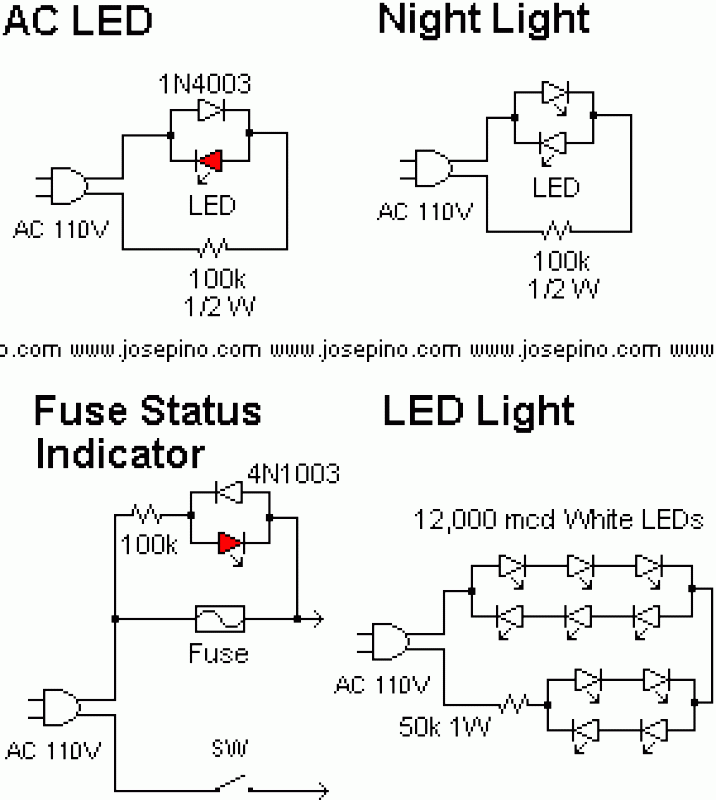
%2BCircuit%2Bdiagram%2Busing%2BCD4047%2Band%2BIRFZ44%2Bpower%2BMOSFET.png)
